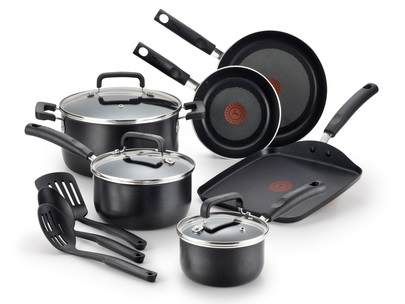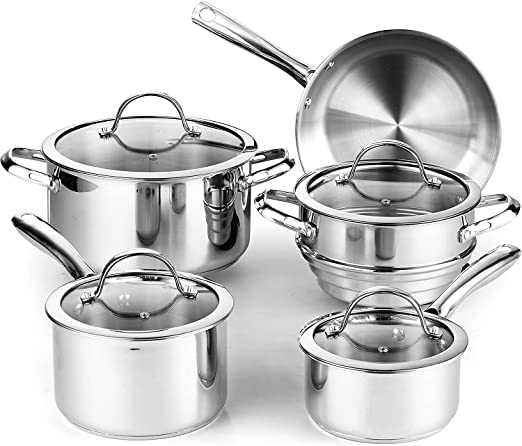Stainless steel or hard anodized – Which is the Better Option? This is the most common dilemmas faced while purchasing cookware.
Each of these categories have their own benefits and drawbacks. So, the answer to this questions is – that it depends on your requirements.
To help you analyse which one is suitable, we have crafted this article. It has the information necessary to take the decision.
Hard-Anodized Vs. Stainless Steel Cookware
Let us have a look at the differences between hard-anodized and stainless-steel cookware in the below table:
| PARAMETER | HARD-ANODIZED | STAINLESS STEEL |
|---|---|---|
| Heat Conducting Capacity | Excellent | Poor |
| Durability | Highly Durable | Highly Durable |
| Safety | Safest | Relatively Safe |
| Non-stick Coating | Present | Absent |
| Maintenance | Not Easy To Maintain | Easy To Maintain |
| Price | Affordable | Expensive |
| Washing | Hand Wash Recommended | Dishwasher Safe |
| Compatibility | Not Compatible With Induction Cooktops | Compatible With Induction Cooktops |
| Non-reactive Nature | Yes | Yes |
Let us discuss in detail the characteristic differences between the duo.
1. Heat Conductivity
Aluminium has excellent heat conducting capacity that allows uniform distribution of heat across the pans and pots. Hence, the food gets cooked quickly and evenly in a shorter time. This makes hard-anodized cookware the most preferred option.
When it comes to stainless steel, it has a poor heat-conducting capacity. However, However, manufacturers use a thick pad of heat conductor material like copper or aluminium inside the steel at the bottom of the utensils as a heat-conducting layer. Just like their hard-anodized counterparts, this layer facilitates even distribution of heat in the stainless-steel utensils.
If you are purchasing a stainless-steel item, do not forget to check whether it is a multi-clad of either copper or aluminium or not.
Winner: Hard-anodized Cookware
2. Durability
Coming to durability, both hard-anodized and stainless-steel cookware are highly durable.
Since hard-anodized utensils have an extra additional layer, they are sturdy and durable in the long run.
Stainless Steel is also tough and durable. Moreover, it can withstand high temperatures. While these utensils are ideal for regular and rough use, hard-anodized cookware is not.
Upon usage, the hard-anodized utensils may lose their non-stick coating. Whereas, a stainless-steel pan or pot is scratch resistant.
Comparatively, stainless steel cookware lasts for many years, and you can use them as long as you want.
Winner: In terms of durability, both seem to get almost equal points.
3. Safety
If you consider the safest option, stainless-steel utensils made of cast iron are the best bet.
In contrary to the above, copper or aluminium cookware without hard anodization can make your food toxic.
Although hard-anodized cookware is safe, it may lose its non-stick coating upon usage. Cooking in such utensils can be harmful to health, as it can emit chemicals into the food.
Winner: Stainless-steel Cookware
4. Non-Stick Coating
As mentioned earlier, hard-anodized cookware has an extra layer of coating over the surface that gives the non-stick ability. It does not allow the food to stick to the pan or pot and encourages only a little amount of oil for use, promoting healthy practice. Moreover, it has resistance to scratches.
On the other hand, the stainless-steel version does not have a non-stick coating. Hence, it does not have non-stick properties. Although it is scratch-resistant, it may be difficult to remove the stains when cleaning the utensils.
Winner: Hard-anodized Cookware
5. Maintenance
When considering the maintenance aspect, both hard-anodized and stainless-steel cookware are easy to maintain. Comparatively, the former is less easy to maintain because it requires only manual washing to clean all the utensils. You cannot put them in the dishwasher as the non-coating surface is prone to damage. Moreover, you cannot use a metal scrubber for cleaning, as it may scratch the coating surface.
If we look at stainless steel, it is not only easy to clean but also dishwasher safe. Because of its durability, it is a great option for daily and rough use.
Winner: Stainless-steel Cookware
6. Price Variation
If we talk about the price, hard-anodized cookware is available in an affordable price range. However, you need to be a little careful with the non-stick surface. Rough or improper handling may reduce the lifespan of the pan or pot.
Whereas, stainless steel products are a little expensive considering their durability and compatibility features. They have a tough surface that can survive high heat temperatures. Some products from this material are very expensive. If budget is not a constraint for you, we recommend choosing stainless-steel cookware.
Winner: Hard-anodized Cookware
What is Hard Anodized Cookware?
Hard-Anodization is the latest technology used in cookware. This is basically a process that uses the electrochemical method to make aluminium stronger than steel. In this method, they dipped the aluminium cookware in the acid and charge it electrically to oxidize it. Thus, the name, hard-anodized cookware. This process not only makes the cookware strong but also increases its lifespan. This makes it durable for a long time.
Unlike stainless-steel cookware, the hard-anodized ones are excellent conductors of heat. In addition to that, they are lightweight than their stainless-steel counterparts. Also, they are easier to clean and maintain. And above all, this cookware comes with a non-stick coating that prevents the food from sticking to the surface, further, making it incredibly easy to clean. This is the USP of the hard-anodized cookware that earned it recognition and popularity.
Pros
- The hard-anodized cookware is easy to cook and clean.
- It is non-reactive to foods and also free from PFOA, PTFE, and other toxic chemicals.
- It is tough, durable, and scratch-resistant.
- It is a great conductor of heat.
- The hard-anodized cookware delivers high cooking performance.
- It enables even distribution of heat across the pan or pot and prevents hotspots.
- It comes with a limited lifetime warranty.
Cons
- The hard-anodized cookware is not ideal for use on high heat.
- You should not use cooking spray on this cookware.
- Manual washing is the only recommended cleaning procedure.
- The hard-anodized cookware is not compatible with induction cooktops.
Click Here To Know Hard Anodized Cookware Disadvantages
What is Stainless Steel Cookware?
Stainless steel is the most widely used cookware found in almost all homes. Because of its durability and user-friendly nature, it is the most sought-after and safest cookware available in the market. It is ideal for regular and rough use, and you do not have to worry about handling it delicately. And, most important of all, it is non-reactive with all foods.
The only disadvantage of stainless steel is that they are relatively a poor conductor of heat. However, they use a thick pad of heat conductor material like copper or aluminium inside the steel at the bottom of the utensils as a heat-conducting layer.
Pros
- Stainless steel is tough and durable, which lasts longer.
- It is easy to maintain.
- Using stainless steel is completely safe.
- Versatile.
- It is compatible with all cooktops, including induction.
- It is non-reactive with all foods.
- A stainless version is dishwasher-friendly. Also, it is safe to use in a broiler and oven.
Cons
- Being lightweight, the stainless-steel pots or pans move easily.
- They are relatively expensive.
- They are a poor heat conductor.
- A little heavy than the hard-anodized cookware.
- Single layered stainless-steel cookware has a poor distribution of heat.
Frequently Asked Questions
Both stainless steel and hard-anodized cookware have their merits and demerits. However, considering the cooking and cleaning parameters, the hard-anodized cookware is better than the stainless-steel version. Moreover, it is much stronger when compared to stainless-steel cookware.
Hard-anodized cookware is the safest option to use. However, you should refrain from cooking at very high temperatures. The maximum temperature recommended for this cookware in the oven is up to 400 degrees Fahrenheit. Nevertheless, we do not recommend overheating.
The hard-anodized cookware is free from toxic chemicals like PFOA, PTFE, Lead, and Cadmium. They are a safe and healthy option to cook.
Stainless steel is absolutely safe to use. Owing to its non-reactive capability, it is the safest option other than a cast iron cookware. Unlike copper and aluminium, cooking in stainless-steel cookware does not pose any health risk.
Ans. People often ask this because Aluminum is a reactive metal and can react with some foods. However, using Hard-Anodized Aluminum Cookware is safe, all thanks to the non-stick coating it comes with. The coating saves the cookware to react with any food and keeps the utensils scratch-proof, and resistant to all kinds of chemical damages as well.
Ans. Yes, there are a few drawbacks of using Hard Anodized Cookware such as you cannot use them for cooking with high heat as it can release toxins. Apart from that, this type of cookware is not dishwasher-friendly and also does not suit induction cooktops.
Conclusion
To conclude, both the products provide some great facilities and are strong, durable, and easy to handle. Both are great options for cooking. However, it all depends on your cooking goals and budget to pick the best one.
I hope this article cleared all your doubts on stainless-steel and hard-anodized cookware. Considering the above analysis, you must now be able to choose the right one.
Write to us if you need more information or have any questions. You also mention any inputs or feedback in the comments section below. Let us know what is your preferred choice and why. We would be happy to hear from you.



